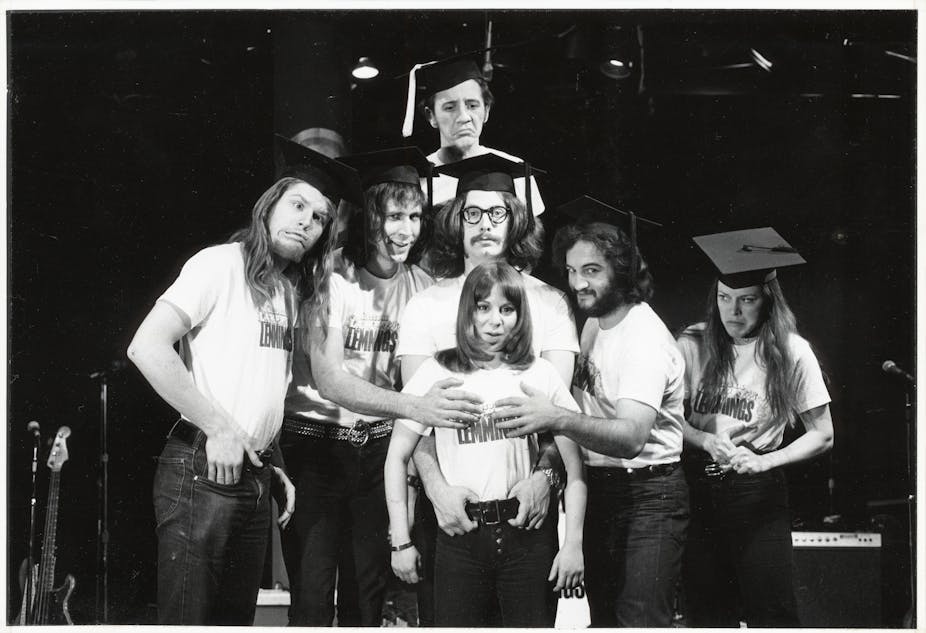More than any other art form, one’s response to a documentary is contingent upon one’s interest in the subject. Show me a documentary about the growth of wheat, no matter how well constructed, and I probably won’t be particularly interested, as much as I love Van Gogh’s Wheat Field with Cypresses (1889).
Douglas Tirola’s Drunk Stoned Brilliant Dead: The Story of the National Lampoon (2015), which screened yesterday at the Sydney Film Festival, is a thoroughly conventional documentary – it consists solely of archival material interspersed with “talking heads” style interviews of key players from the era – but, as the story of the birth and flourishing of the National Lampoon magazine from the early 1970s through to its virtual death in the 1980s, it’s completely engrossing.
Almost every kid growing up in Anglophone suburbia in the 1970s and 1980s would be familiar with the films of these (once) iconoclastic comedians – Belushi, Chase, Murray and Ramis have become virtually household names.
What many of us perhaps didn’t know is that the National Lampoon movies, from the brilliant Animal House (1978) through to the woeful Last Resort (1994), owe their legacy to the eponymous magazine created by Doug Kenny and Henry Beard that emerged from the Harvard Review in 1970.

Tirola’s film documents the rise of the magazine, its struggles to stay afloat through advertising (a Christian Coalition attack against the magazine following its “baby in the blender” graphic saw it lose most of its national advertising in the mid 1980s), its recruitment of Second City comedians for the National Lampoon Radio Hour, the production of Animal House (1978), and so on.
This (ironically) conventionally American story of the rise and fall of an enterprise – Citizen Kane for the sex, drugs and rock ‘n’ roll generation – is told in the context of Doug Kenny’s burgeoning cocaine addiction and his eventual death in Hawaii in 1980, aged 33 (including a candid interview with Chevy Chase where he comes to the verge of tears discussing the death of his “best friend”).

The film’s argument that the advent of Saturday Night Live in 1975 virtually drained the magazine of all of its talent may be of particular interest to fans of American comedy from the period. Around the same time, PJ O’Rourke became editor-in-chief of the magazine, John Hughes became one of its main contributors, and the National Lampoon, so several of the interviewees point out, became a much less fun place to work.
There are interviews with assorted well-known faces and movie stars discussing the influence the magazine had on them personally as well as on their careers, along with lesser known writers and illustrators who worked for the magazine.
John Goodman appears, praising the magazine, so does Meat Loaf and Kevin Bacon.
Judd Apatow attributes his formation as a comic writer to the magazine. Billy Bob Thornton, at one point, offers the observation (pithy or otherwise) that an encounter with National Lampoon “was the first time that [he] realised:
through humour, you can tell the truth.
Probably the most intriguing of the archival footage is an interview with Canadian media theorist Marshall McLuhan (famous for coining the phrases "the medium is the message” and “the global village”).
McLuhan, interviewed in grainy black and white, praises the magazine while at the same time expressing doubts regarding its validity as a “countercultural” artifact. In response to a question regarding the popularity of the magazine, he says that it’s partly because “they’re very witty,” but also (and more significantly) because “they are designed to please – and flatter – a particular audience of fairly well to do nobodies. Who can afford to be nobodies”.
In the context of Vietnam, Watergate, the 1970s – for those interested, the most effective depiction of the 1970s American zeitgeist remains Robert Stone’s novel Dog Soldiers (1974) – perhaps this is an unfair comment by McLuhan.

There clearly is a political position underpinning the early issues of the magazine – against racism, against religious zealotry, against Vietnam – even if this is interspersed with raunchy images and jokes that are at times hilarious and at times merely stupid.
The film is, certainly, great in its documentation of life in the countercultural 70s – but there is perhaps some niggling truth to McLuhan’s point about the magazine in the first place. What was it but a kind of literary masturbatorium for college kids wishing to break away from their well-to-do parents?
In any case, McLuhan’s point touches on two larger issues only hinted at in the film, that endow the film with significance beyond middling biographical interest.
The first is a reminder of the destructive tendencies of the commodification of art – the film clearly maps the story of a radical (and groundbreaking) magazine that increasingly disintegrates with each additional level of corporatisation. In our current age of the reification of every living impulse, this is particularly resonant.
The second, more topical issue is raised by National Lampoon writer-editor Tony Hendra in a contemporary interview in the film:
It is the job of a satirist, okay, to make people in power uncomfortable. Really uncomfortable – to the point where they go, ‘this has to be stopped’.
In the context of the global (Western) support of everything Charlie Hebdo, this is a crucial point to keep in mind. Satire, for it to be effective (and, even, I’d say, justified) must be directed against the powerful.
If it’s directed against a minority, what is it other than a new version of Black Face, a mean, idiotic demonstration and celebration of the powerful bashing the weak? People should bear this in mind when they spout platitudes about “free speech” in their hagiographies of the so-called “satirists” of Charlie Hebdo.
Drunk Stoned Brilliant Dead: The Story of the National Lampoon was shown yesterday as part of the Sydney Film Festival 2015. Details here.

